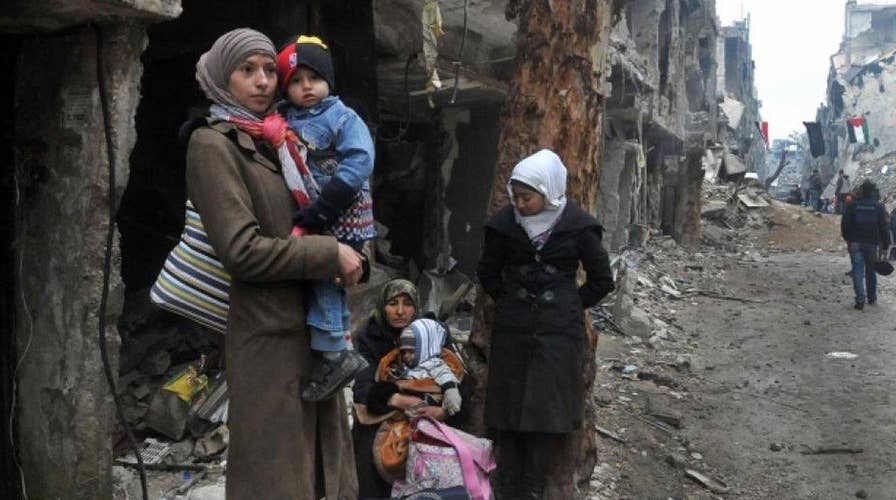How Syrian refugee crisis could impact sanctions on Russia
Insight from Andrew Tabler, author of 'In the Lion's Den: An Eyewitness Account of Washington's Battle with Syria'
We’ve seen this movie—now playing in Syria-- before.
The Russians have developed a way of getting the U.S. formally to permit offensive Russian military operations against American partners on the ground, all the while calling it a ceasefire.
What the Russians are proposing in Syria—a “cessation of hostilities” on terms they get to define-- is exactly what they have been doing in Eastern Ukraine for more than a year.
The Minsk II accords, signed in February 2015 between Russia, Ukraine, France and Germany, with the U.S. in support, supposedly established a “cessation of hostilities” across all of Ukraine. But Russian proxies on the ground, with active Russian support, have continued to attack Ukrainian positions while loudly blaming the Ukrainians for violating the ceasefire.
Then as now, humanitarian concerns were a prime motive. The West thought the Ukraine ceasefire would keep pro-Russian forces from seizing the town of Debal’tseve, then under siege. But Russian proxies took Debal’tseve three days after the ceasefire came into effect.
Putin will use exactly the same techniques in Syria to achieve a similar objective—the weakening or destruction of opposition forces the U.S. has been supporting.
This matters, because Aleppo is one of the last few bastions for opposition groups that offers any hope of a future Syria that is neither brutally oppressed by Assad nor controlled by Al Qaeda and/or ISIS.
The Russians, of course, claim that all of the groups in northern Syria are Al Qaeda or ISIS or their allies.
That claim is a lie.
The opposition in Aleppo includes groups that the U.S. has been supporting. Several of those groups have received TOW missiles from the U.S., indicating that they have passed a rigorous vetting process designed to ensure that those weapons will not end up in the hands of ISIS and al Qaeda.
The Russian false claim that it is fighting terrorists is a cynical device to conceal Putin’s real aim, which is to re-establish the vicious dictatorship of Bashar al-Assad in order to guarantee Russia’s possession of air and naval bases on the Mediterranean littoral.
What will happen next?
Here’s a version of the worst case. Syrian forces, heavily supported by Lebanese Hezbollah, Iraqi Shi’a militias, and Iranian troops, still backed by extensive Russian air strikes, will continue their offensive operations around Aleppo, further isolating the opposition in that city and expanding the Assad regime’s control.
They will also continue to strike civilian targets in the area, creating additional tens of thousands of internally-displaced people and increasing the refugee flow to Turkey.
Secretary Kerry will no doubt launch strong protests with the Kremlin over this issue, but the Obama Administration will take no other action.
The regime will thus complete its encirclement of Aleppo and proceed to the destruction of the groups the U.S. has been supporting--all in the name of a process that the U.S. has just agreed to.
The net result will be the further weakening of any moderate opposition the U.S. could work with and the strengthening of Al Qaeda, ISIS, and their allies.
For one thing, these military operations will disproportionately damage the remaining opposition without striking areas that sustain ISIS and Al Qaeda in Syria.
For another, they will powerfully reinforce the claims made by ISIS and Al Qaeda that the U.S. has thrown in completely with Assad and will support the dictator’s efforts to crush the Sunni population, and that ISIS and Al Quaeda alone are the Sunni defenders.
In this way, the Russians will make their lies come true.
We have watched the Russians execute this playbook in Ukraine for more than a year. The Russians have actually published descriptions of how they manipulate the West in precisely this fashion and that they have made it their policy to do so.
Manipulating the U.S. to support Russia’s aims is, in fact, Putin’s primary goal and purpose.
It is astonishing that anyone who has participated in this scenario in Ukraine over the last year could imagine that the outcome will be different in Syria this time.
And yet, at Foggy Bottom and in the White House, they apparently do.
Frederick W. Kagan is the director of the Critical Threats Project at the American Enterprise Institute. Kimberly Kagan is president of the Institute for the Study of War.

